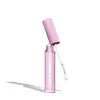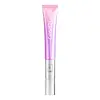What's inside
What's inside
 Key Ingredients
Key Ingredients

 Benefits
Benefits

 Concerns
Concerns

No concerns
 Ingredients Side-by-side
Ingredients Side-by-side

Water
Skin ConditioningPropylene Glycol
HumectantGlycerin
HumectantButylene Glycol
HumectantGlycereth-26
HumectantHydrolyzed Collagen
EmollientPropanediol
Solvent1,2-Hexanediol
Skin ConditioningHydroxyacetophenone
AntioxidantSodium Hyaluronate
HumectantHydroxyethylcellulose
Emulsion StabilisingSodium Chloride
MaskingPEG-40 Hydrogenated Castor Oil
EmulsifyingXanthan Gum
EmulsifyingHydrolyzed Pea Protein
EmollientEthylhexylglycerin
Skin ConditioningTocopherol
AntioxidantPanax Ginseng Root Extract
EmollientBiotin
AntiseborrhoeicTripeptide-1
Skin ConditioningPalmitoyl Pentapeptide-4
Skin ConditioningWater, Propylene Glycol, Glycerin, Butylene Glycol, Glycereth-26, Hydrolyzed Collagen, Propanediol, 1,2-Hexanediol, Hydroxyacetophenone, Sodium Hyaluronate, Hydroxyethylcellulose, Sodium Chloride, PEG-40 Hydrogenated Castor Oil, Xanthan Gum, Hydrolyzed Pea Protein, Ethylhexylglycerin, Tocopherol, Panax Ginseng Root Extract, Biotin, Tripeptide-1, Palmitoyl Pentapeptide-4
Water
Skin ConditioningGlycerin
HumectantDimethicone
EmollientMethylpropanediol
SolventCoco-Caprylate/Caprate
EmollientMaris Aqua
HumectantCyclopentasiloxane
EmollientCetyl Alcohol
EmollientOctyldodecanol
EmollientGlyceryl Stearate
EmollientNiacinamide
SmoothingCyclohexasiloxane
EmollientHydroxyacetophenone
AntioxidantMethyl Hydrogenated Rosinate
PerfumingAmmonium Acryloyldimethyltaurate/Vp Copolymer
PEG-75 Stearate
Tocopheryl Acetate
AntioxidantSteareth-20
CleansingCeteth-20
CleansingButylene Glycol
HumectantBisabolol
MaskingPentylene Glycol
Skin ConditioningLactobacillus/Soymilk Ferment Filtrate
Skin ConditioningGentiana Scabra Root Extract
Skin ConditioningHydroxyphenyl Propamidobenzoic Acid
Skin ConditioningCaffeine
Skin ConditioningSodium Hyaluronate
HumectantPalmitoyl Pentapeptide-4
Skin ConditioningTocopherol
AntioxidantCeramide EOP
Skin ConditioningCeramide AP
Skin ConditioningCeramide Ns
Skin ConditioningCeramide As
Skin ConditioningAcetyl Tetrapeptide-5
HumectantDipeptide Diaminobutyroyl Benzylamide Diacetate
Skin ConditioningChondrus Crispus Extract
Skin ConditioningSmithsonite Extract
AntioxidantPeumus Boldus Leaf Extract
MaskingMoringa Oleifera Seed Extract
Skin ConditioningZea Mays Kernel Extract
Palmaria Palmata Extract
Skin ProtectingPhytosteryl/Octyldodecyl Lauroyl Glutamate
Skin ConditioningCeramide NP
Skin ConditioningEchinacea Purpurea Extract
MoisturisingAscorbyl Palmitate
AntioxidantLycium Barbarum Fruit Extract
AstringentTrehalose
HumectantSophora Flavescens Root Extract
AntioxidantAloe Barbadensis Leaf Extract
EmollientHydrogenated Lecithin
EmulsifyingDendrobium Nobile Stem Extract
Skin ConditioningErythritol
HumectantXanthan Gum
EmulsifyingPentaerythrityl Tetra-Di-T-Butyl Hydroxyhydrocinnamate
AntioxidantDisodium EDTA
Cyclodextrin
AbsorbentPolysorbate 20
EmulsifyingCarbomer
Emulsion StabilisingArginine
MaskingWater, Glycerin, Dimethicone, Methylpropanediol, Coco-Caprylate/Caprate, Maris Aqua, Cyclopentasiloxane, Cetyl Alcohol, Octyldodecanol, Glyceryl Stearate, Niacinamide, Cyclohexasiloxane, Hydroxyacetophenone, Methyl Hydrogenated Rosinate, Ammonium Acryloyldimethyltaurate/Vp Copolymer, PEG-75 Stearate, Tocopheryl Acetate, Steareth-20, Ceteth-20, Butylene Glycol, Bisabolol, Pentylene Glycol, Lactobacillus/Soymilk Ferment Filtrate, Gentiana Scabra Root Extract, Hydroxyphenyl Propamidobenzoic Acid, Caffeine, Sodium Hyaluronate, Palmitoyl Pentapeptide-4, Tocopherol, Ceramide EOP, Ceramide AP, Ceramide Ns, Ceramide As, Acetyl Tetrapeptide-5, Dipeptide Diaminobutyroyl Benzylamide Diacetate, Chondrus Crispus Extract, Smithsonite Extract, Peumus Boldus Leaf Extract, Moringa Oleifera Seed Extract, Zea Mays Kernel Extract, Palmaria Palmata Extract, Phytosteryl/Octyldodecyl Lauroyl Glutamate, Ceramide NP, Echinacea Purpurea Extract, Ascorbyl Palmitate, Lycium Barbarum Fruit Extract, Trehalose, Sophora Flavescens Root Extract, Aloe Barbadensis Leaf Extract, Hydrogenated Lecithin, Dendrobium Nobile Stem Extract, Erythritol, Xanthan Gum, Pentaerythrityl Tetra-Di-T-Butyl Hydroxyhydrocinnamate, Disodium EDTA, Cyclodextrin, Polysorbate 20, Carbomer, Arginine
Ingredients Explained
These ingredients are found in both products.
Ingredients higher up in an ingredient list are typically present in a larger amount.
Butylene Glycol (or BG) is used within cosmetic products for a few different reasons:
Overall, Butylene Glycol is a safe and well-rounded ingredient that works well with other ingredients.
Though this ingredient works well with most skin types, some people with sensitive skin may experience a reaction such as allergic rashes, closed comedones, or itchiness.
Learn more about Butylene GlycolGlycerin is already naturally found in your skin. It helps moisturize and protect your skin.
A study from 2016 found glycerin to be more effective as a humectant than AHAs and hyaluronic acid.
As a humectant, it helps the skin stay hydrated by pulling moisture to your skin. The low molecular weight of glycerin allows it to pull moisture into the deeper layers of your skin.
Hydrated skin improves your skin barrier; Your skin barrier helps protect against irritants and bacteria.
Glycerin has also been found to have antimicrobial and antiviral properties. Due to these properties, glycerin is often used in wound and burn treatments.
In cosmetics, glycerin is usually derived from plants such as soybean or palm. However, it can also be sourced from animals, such as tallow or animal fat.
This ingredient is organic, colorless, odorless, and non-toxic.
Glycerin is the name for this ingredient in American English. British English uses Glycerol/Glycerine.
Learn more about GlycerinHydroxyacetophenone is antioxidant with skin conditioning and soothing properties. It also boosts the efficiency of preservatives.
This ingredient is not irritating or sensitizing.
You might know this ingredients as Matrixyl, a famous peptide.
Peptides are building blocks for protein. Palmitoyl Pentapeptide-4 consists of five amino acids. These amino acids include: 2 lysines, 2 threonines, and serine
This ingredients tells our body to create more collagen. Collagen is a protein that makes connective tissue. Boosting collagen production leads to a healthier skin barrier. Having a healthy skin barrier means having firm and hydrated skin.
Thus, Matrixyl may help improve the look of wrinkles.
Read more about other common types of peptides here:
Learn more about Palmitoyl Pentapeptide-4Sodium Hyaluronate is hyaluronic acid's salt form. It is commonly derived from the sodium salt of hyaluronic acid.
Like hyaluronic acid, it is great at holding water and acts as a humectant. This makes it a great skin hydrating ingredient.
Sodium Hyaluronate is naturally occurring in our bodies and is mostly found in eye fluid and joints.
These are some other common types of Hyaluronic Acid:
Learn more about Sodium HyaluronateTocopherol (also known as Vitamin E) is a common antioxidant used to help protect the skin from free-radicals and strengthen the skin barrier. It's also fat soluble - this means our skin is great at absorbing it.
Vitamin E also helps keep your natural skin lipids healthy. Your lipid skin barrier naturally consists of lipids, ceramides, and fatty acids. Vitamin E offers extra protection for your skin’s lipid barrier, keeping your skin healthy and nourished.
Another benefit is a bit of UV protection. Vitamin E helps reduce the damage caused by UVB rays. (It should not replace your sunscreen). Combining it with Vitamin C can decrease sunburned cells and hyperpigmentation after UV exposure.
You might have noticed Vitamin E + C often paired together. This is because it is great at stabilizing Vitamin C. Using the two together helps increase the effectiveness of both ingredients.
There are often claims that Vitamin E can reduce/prevent scarring, but these claims haven't been confirmed by scientific research.
Learn more about TocopherolWater. It's the most common cosmetic ingredient of all. You'll usually see it at the top of ingredient lists, meaning that it makes up the largest part of the product.
So why is it so popular? Water most often acts as a solvent - this means that it helps dissolve other ingredients into the formulation.
You'll also recognize water as that liquid we all need to stay alive. If you see this, drink a glass of water. Stay hydrated!
Learn more about WaterXanthan gum is used as a stabilizer and thickener within cosmetic products. It helps give products a sticky, thick feeling - preventing them from being too runny.
On the technical side of things, xanthan gum is a polysaccharide - a combination consisting of multiple sugar molecules bonded together.
Xanthan gum is a pretty common and great ingredient. It is a natural, non-toxic, non-irritating ingredient that is also commonly used in food products.
Learn more about Xanthan Gum